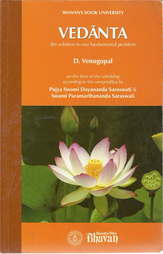Q: In Advaita one learns to ‘unravel’ objects: table as wood, wood as cells, cells as molecules, molecules as atoms, atoms as subatomic particles, etc. (neti neti!) all the way down. What Advaita says ‘lies at the bottom’ is Brahman, the oneness from which all apparent objects of form manifest.
What seems just as (if not more) intuitively plausible to me is that what lies at the bottom is: a few primal emergent ‘rules’. Perhaps even just one rule: attraction/repulsion. Electrons are attracted to protons and repelled by other electrons giving way to atoms, atoms are attracted to other atoms giving way to molecules, and so on, all the way up to the forms we know and love.
In this view of reality, there is no top-level overarching ‘organizational’ principle: Consciousness. There is instead a vast web of ‘stuff’ that arises from a few simple low-level emergent rules. As with all emergent systems, the application of these rules, once sufficiently complex, creates a system that seems to have an overarching top-level intelligence/intentionality/organizational principle, but in reality doesn’t.
So, friends: Who wins? Emergence or Consciousness? Or is it a non-zero-sum game: Are emergence and Consciousness not mutually exclusive?
A (Dennis): If you have read my articles about science and its views, you will know that I do not regard it very highly when it comes to consciousness and reality!
The ‘unraveling’ is an explanation of the concept of mithyA and provides an intuitively reasonable explanation as to why all ‘things’ are just name and form of brahman. If you try to turn this around you are then tacitly assuming that the empirical reality has some absolute reality, which it doesn’t (unless you are just accepting that ‘everything is brahman’). Or you are just attempting to use science to ‘explain’ Ishvara. Because Advaita would call your ‘fundamental laws’ or ‘primary emergent rules’ Ishvara. Ishvara is both intelligent and material cause for the (apparent) creation. In reality, of course, there has never been any creation. Both the ocean (universe) and the wave (individual) are always only water.

